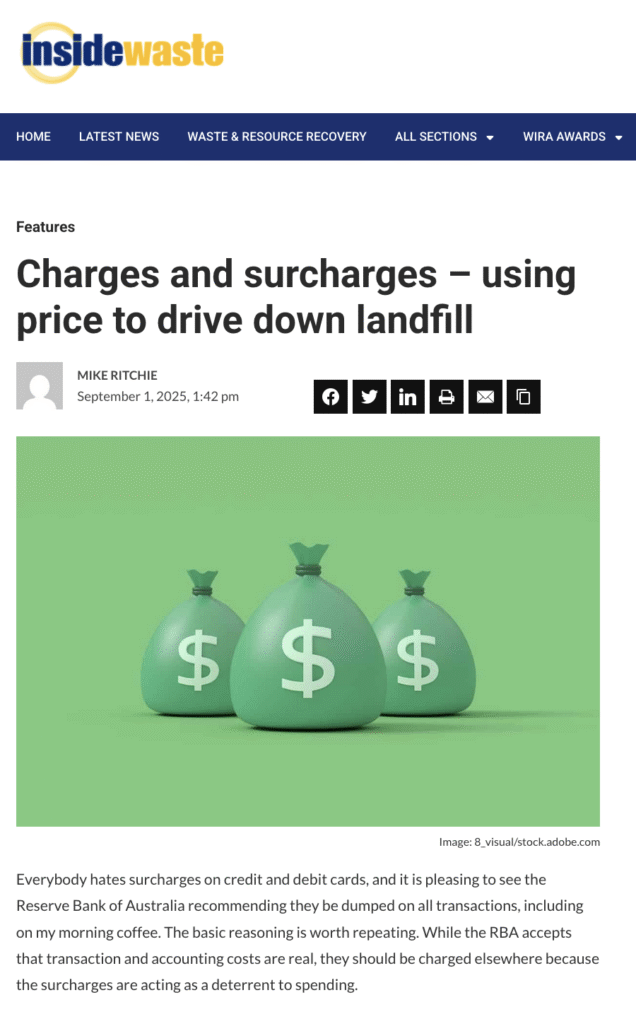Charges and Surcharges – using price to drive down landfill
By: Mike Ritchie, MRA Consulting Group

Everybody hates surcharges on credit and debit cards, and it is pleasing to see the Reserve Bank of Australia recommending they be dumped on all transactions, including on my morning coffee.
The basic reasoning is worth repeating.
While the RBA accepts that transaction and accounting costs are real, they should be charged elsewhere because the surcharges are acting as a deterrent to spending.
As they have said repeatedly, we should remove taxes on things we want people to purchase and instead put them on things we don’t want people to buy.
My coffee should be tax free, but my cigarettes should not (so to speak. I am a non-smoker as I hope you are, dear reader).
Tax the things we want less of and remove taxes on things we want more of. Simple economics. The higher the price, the less people are willing to pay for it and the less they consume of it.
Which brings me to waste. We want people to landfill less and recycle more.
So, following the same logic we should tax landfills and remove taxes on recycling and resource recovery.
Simple economics.
To their credit in the last 15 years most major States have introduced landfill taxes (called levies to avoid political point scoring by opponents) and used the revenue to provide some incentives for investment in recycling.
Good economics, so far.
But while there has been progress, the rate of reform has stalled, and with it, the growth of recycling (compared to landfilling). The statistics now show us that landfilling is still rising and recycling has stalled.
We can particularly see that in NSW where, while the levy raises $900m/yr, investment and hypothecation of the levy (to local government, infrastructure etc) has fallen from $120m/yr to approximately $60m/yr. 6% hypothecation just doesn’t cut it.
The result has been a significant drop in capital investment, stalling of NSW EPA waste programs and investors voting with their feet by going to other States.
I just don’t get it.
A message to all State Governments. The levy is sound economics. It provides funds to Treasury to spend on recycling as well as on schools, roads and police. It is a progressive tax (it taxes consumption). It rebalances recycling economics compared to underpriced landfills. It drives recycling. The community, by and large, understand the need for it and accept it.
Here is why we need levy reform. We still landfill:
- 6 million tonnes of organics per year (generating 11 MT of greenhouse gas emissions);
- 7 million tonnes of mixed commercial material; and
- 8 million tonnes of mixed construction material.
Why?
Because it is still cheaper (i.e. economically rational) to landfill this material, than to recycle it.
So why don’t State Governments go further?
I think it is a because some advocates oppose levies on cost-of-living grounds. I respect this point of view. Cost of living matters.
In fact, I would argue it would be rational to run super cheap landfills across Australia for cost-of-living reasons. Just make all disposal as cheap as possible.
However, I would point out a couple of things:
- Landfilling would rise immediately
- Recycling would crash and with it lots of jobs
And
- If we must have taxes it is better we tax things we want less of
- It is better we tax things that cause harm so that we do less of them
- It is better that the taxes be progressive and not hurt the poor
- It is better that the taxes add to economic activity and jobs growth.
Landfill levies do all of those things.
The next best criticism of landfill levies is that State treasuries hog the money and don’t hypothecate enough of it back to recycling (which is the purpose of the levies in most State legislation). I agree.
It is extremely short sighted of Treasurers to do this. The levies could play a long-term role in revenues for Treasuries if only they had proper acceptance.
The gap is not that big. Treasurers – think about giving local government a bit more back please.
Some key facts about levies that you may not know:
- Local governments pay about 30% of landfill levies. 70% is paid by business (who generate 70% of waste to landfill).
- Hypothecation rates range from 7%-50% across States. Some use it to pay for their Environment departments. Hypothecation rates are too low.
- In QLD councils were 100% compensated for levy payments. Good idea as an introduction. The compensation winds down over time as an incentive to divert more material from landfill.
- The more levy funds are hypothecated to local government and infrastructure the faster recycling will grow and with it jobs and economic activity.
- Levies make recycling competitive with landfill. They rebalance the economics.
It is not all about levies but they are the key economic instrument. As an alternative, governments could simply ban stuff from landfill but they have shown little willingness to go there. There are really no effective bans on materials to landfill, at any scale, in Australia. So levies are the best instrument on the table.
Here are three statistics to reinforce the point:
- Since the introduction of levies, recycling has grown from 7% (1.5mt) in 1998, to 63% (45mt) in 2023.
- The recycling sector now employs 65,000 Australians directly and 4 x that indirectly.
- Recycling employs 4x the number of people than landfilling does per tonne.
- Levies have lifted the cost of landfilling by a weighted average $106/t across Australia.
As governments have done with taxes on cigarettes, they need to do with levies on landfills. And they need to go further. How far?
To the point where we stop wasting highly recoverable materials to landfill. There is a sensible maximum, (after which levies have a distortionary effect.) Some might argue this is where tobacco taxes are at present.
But we are nowhere near a sensible maximum.
We still landfill at least 10 mt/yr of useful recoverable materials (and that is a conservative estimate).
Wishful thinking won’t divert it from landfill. Levies will.
State governments just need to be smarter about the level and targeting of hypothecated levy funds to ensure councils are compensated and it is not seen as a cost shifting, or purely revenue raising, exercise.
That should not be beyond the wit of Treasurers, Treasury departments and Environment agencies.
I, and many others, want to help Treasuries raise more money from landfill levies and with that, to help grow recycling in Australia and support local government. Treasuries just need to do do it the right way.
Even the RBA thinks that the right taxes, done the right way, are appropriate.
Done right, industry and local government will back this reform.
Mike Ritchie is the Managing Director at MRA Consulting Group.
This article has been published by the following media outlets:




